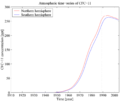Top Qs
Timeline
Chat
Perspective
Trichlorofluoromethane
Type of chlorofluorocarbon (CFC-11) From Wikipedia, the free encyclopedia
Remove ads
Trichlorofluoromethane, also called freon-11, CFC-11, or R-11, is a chlorofluorocarbon (CFC). It is a colorless, faintly ethereal, and sweetish-smelling liquid that boils around room temperature.[5] CFC-11 is a Class 1 ozone-depleting substance which damages Earth's protective stratospheric ozone layer.[6] R-11 is not flammable at ambient temperature and pressure but it can become very combustible if heated and ignited by a strong ignition source.
Remove ads
Historical use
Trichlorofluoromethane was first widely used as a refrigerant. Because of its high boiling point compared to most refrigerants, it can be used in systems with a low operating pressure, making the mechanical design of such systems less demanding than that of higher-pressure refrigerants R-12 or R-22.
Trichlorofluoromethane is used as a reference compound for fluorine-19 NMR studies.
Trichlorofluoromethane was formerly used in the drinking bird novelty, largely because it has a boiling point of 23.77 °C (74.79 °F). The replacement, dichloromethane, boiling point 39.6 °C (103.3 °F), requires a higher ambient temperature to work.
Prior to the knowledge of the ozone depletion potential of chlorine in refrigerants and other possible harmful effects on the environment, trichlorofluoromethane was sometimes used as a cleaning/rinsing agent for low-pressure systems.[7]
Remove ads
Production
Trichlorofluoromethane can be obtained by reacting carbon tetrachloride with hydrogen fluoride at 435 °C and 70 atm, producing a mixture of trichlorofluoromethane, tetrafluoromethane and dichlorodifluoromethane in a ratio of 77:18:5. The reaction can also be carried out in the presence of antimony(III) chloride or antimony(V) chloride:[8]
- CCl4 + HF → CCl3F + CF4 + CCl2F2
Trichlorofluoromethane is also formed as one of the byproducts when graphite reacts with chlorine and hydrogen fluoride at 500 °C.[8]
Sodium hexafluorosilicate under pressure at 270 °C, titanium(IV) fluoride, chlorine trifluoride, cobalt(III) fluoride, iodine pentafluoride, and bromine trifluoride are also suitable fluorinating agents for carbon tetrachloride.[8][9]
- CCl4 + Na2SiF6 → CCl3F + CCl2F2 + CCl3F + NaCl + SiF4
- CCl4 + BrF3 → BrF + CCl2F2 + CCl3F
Trichlorofluoromethane was included in the production moratorium in the Montreal Protocol of 1987. It is assigned an ozone depletion potential of 1.0, and U.S. production was ended on January 1, 1996.[6]
Remove ads
Regulatory challenges
In 2018, the atmospheric concentration of CFC-11 was noted by researchers to be declining more slowly than expected,[10][11] and it subsequently emerged that it remains in widespread use as a blowing agent for polyurethane foam insulation in the construction industry of China.[12] In 2021, researchers announced that emissions declined by 20,000 U.S. tons from 2018 to 2019, which mostly reversed the previous spike in emissions.[13] In 2022, the European Commission announced an updated regulation that mandates the recovery and prevention of emissions of CFC-11 blowing agents from foam insulation in demolition waste, which is still emitted at significant scale.[14]
Dangers
R11, like most chlorofluorocarbons, forms phosgene gas when exposed to a naked flame.[15]
Use in Planetary Astrophysics
Because trichlorofluoromethane is one of the easiest to detect chlorofluorocarbons produced by anthropogenic activity, it has been used in attempting to detect industrial pollution in the atmospheres of earth-like exoplanets.[16]
Gallery
- CFC-11 measured by the Advanced Global Atmospheric Gases Experiment (AGAGE) in the lower atmosphere (troposphere) at stations around the world. Abundances are given as pollution free monthly mean mole fractions in parts-per-trillion.
- Hemispheric and Global mean concentrations of CFC-11 (NOAA/ESRL)
- Time-series of atmospheric concentrations of CFC-11 (Walker et al., 2000)
- "Present day" (1990s) sea surface CFC-11 concentration
- "Present day" (1990s) CFC-11 oceanic vertical inventory
Remove ads
See also
References
External links
Wikiwand - on
Seamless Wikipedia browsing. On steroids.
Remove ads







